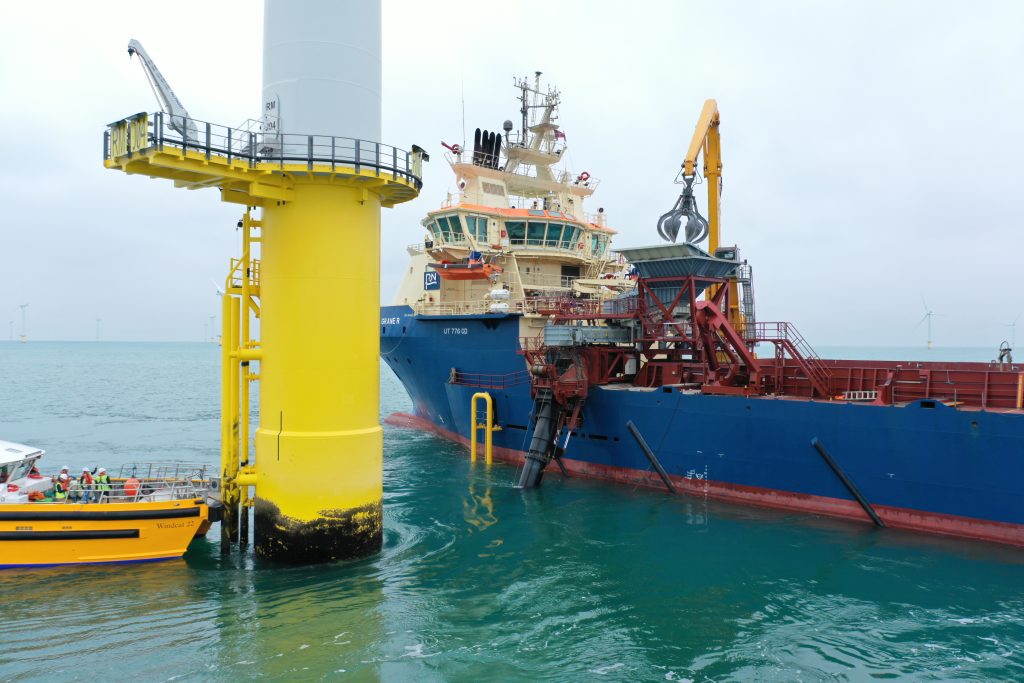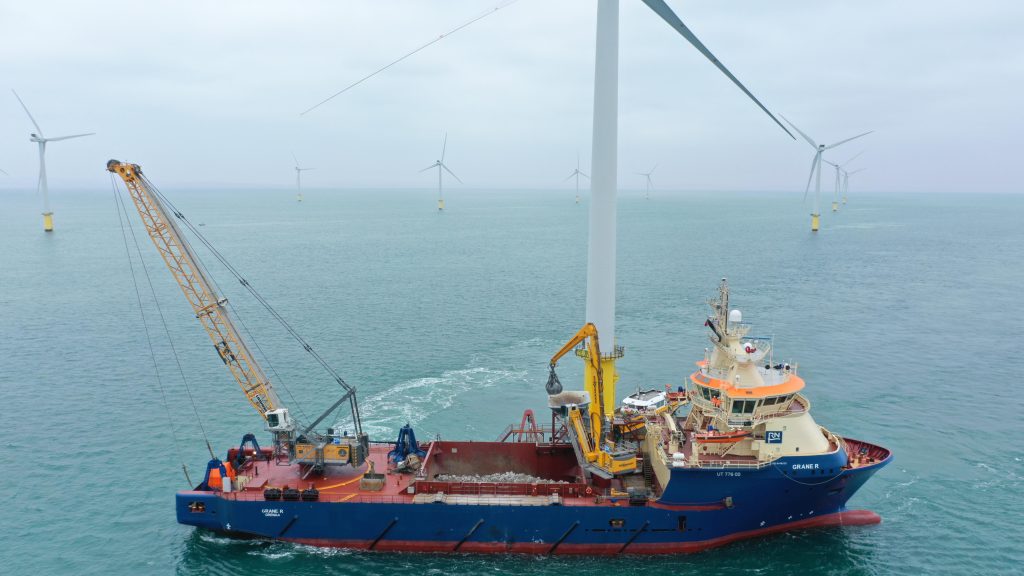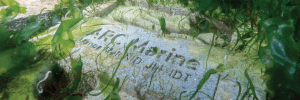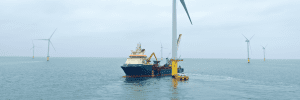Offshore wind is evolving. As the industry grows, so does its responsibility to design infrastructure that protects both assets and ecosystems.
At Rampion Offshore Wind Farm, ARC marine® and RWE have delivered the world’s first full-scale Reef-Enhancing Scour Protection (RESP) system, a new generation of turbine protection that restores as it protects.
Why do wind turbines need scour protection?
At the base of every offshore wind turbine, powerful currents can erode the seabed, threatening the stability of the foundation. This process, known as scour, occurs when fast-moving water removes sediment from around the monopile or jacket base.
Without scour protection, a turbine’s foundation could become exposed, undermining its structural integrity and increasing maintenance costs.
How is scour protection normally installed?
Traditionally, scour protection for offshore wind turbines involves placing two layers of quarried rock: a filter layer to stabilise the seabed and an armour layer to absorb the energy of tidal and wave forces.
While this method is proven, it is resource-intensive, carbon-heavy and delivers little ecological value. Once a project reaches the end of its life, this rock must be removed and disposed of, a complex, diesel-fuelled process with high cost and carbon impact.
Conventional scour protection safeguards the turbine but does little for the surrounding environment.
What makes RESP different?
ARC marine set out to change this, creating a system that not only protects wind turbine foundations but actively restores the marine environment around them.
RESP replaces quarried rock with Reef cubes® which are modular, leachate-free concrete units made from 98% recycled, low-carbon, plastic-free materials.
Each cube’s interlocking geometry resists movement, stabilises sediments and provides thousands of microhabitats for marine species. RESP merges the roles of both filter and armour layers into a single, modular system that reduces installation time, vessel days and overall carbon footprint.
Once installed, RESP forms a permanent reef foundation that supports biodiversity throughout the lifespan of the turbine and beyond.

How was RESP developed and tested?
The RESP system at Rampion Offshore Wind Farm builds on years of R&D by ARC marine’s engineering and science teams. Supported by Innovate UK and the European Innovation Council, extensive laboratory and field testing proved Reef cubes® could reduce scour, withstand high-energy conditions and accelerate colonisation by reef-building organisms.
That evidence made it possible to move from small-scale trials to full-scale deployment.
What happened at Rampion Offshore Wind Farm?
In October 2025, more than 75,000 Reef cubes® were installed across 820 m² of seabed at one of Rampion’s turbine foundations in partnership with RWE.
Early modelling indicates the RESP system creates around 25% more surface area and up to 14× more internal habitat space than conventional rock armour. Every surface becomes an opportunity for life to take hold, turning turbine foundations into living reef systems.
“RESP is proof that smart engineering can protect critical energy infrastructure and regenerate life around it,” says Harrison Short, Head of Engineering at ARC marine.
How does RESP fit into current offshore wind practices?
RWE’s deployment demonstrates how biodiversity-enhancing scour protection can align with existing offshore installation processes. RESP uses the same vessels, handling equipment and teams as traditional rock, allowing developers to integrate ecological benefits without additional complexity.
As David Blake, Sales Director at ARC marine, explains, “RESP has been designed with current processes taken into consideration. It meets engineering requirements and aligns with emerging Nature-Inclusive Design (NID)expectations.”
How does RESP support Nature-Inclusive Design (NID)?
RESP forms part of ARC marine’s wider effort to embed Nature-Inclusive Design (NID) into offshore infrastructure. The project helped shape PAS 1401:2025 – Nature-Inclusive Marine Structures, the first BSI standard defining how to integrate ecological value into marine and offshore developments.
You can learn more or download the PAS document here.
How will RESP be monitored?
The Rampion RESP system will undergo a multi-year monitoring programme (2026–2030) to track colonisation and stability. Ecological and geophysical data will be shared with the wider industry to guide future policy, best practice and biodiversity targets for offshore wind development.

What about scour protection for cables and pipelines?
Alongside foundation scour protection, ARC marine has developed Reef mat, an articulated concrete mattress that protects subsea cables and pipelines from scour and impact.
Made from low-carbon concrete and up to 98% recycled aggregates, Reef mats are engineered to PAS 1401:2025, contain zero plastic and are fully Dutch leachate certified. Each mat offers additional biodiversity enhancement while remaining compatible with existing offshore installation methods.
Together, RESP and Reef mat provide a complete suite of sustainable turbine and cable protection solutions that deliver measurable environmental gain.
About ARC marine
ARC marine is a UK-based eco-engineering company pioneering Nature-Inclusive Design (NID) solutions for offshore wind, coastal defence and marine restoration.
Our patented Reef cubes®, Reef mat and Reef wall systems deliver structural stability, ecological enhancement and carbon reduction at scale. By integrating biodiversity-positive design into industrial infrastructure, ARC marine is helping restore ocean life while supporting the global transition to renewable energy.
Have a project that could benefit from reef-enhancing scour protection or sustainable turbine foundations?
Contact our team →
Learn more about Reef cubes® →
Learn more about PAS 1401:2025 – Nature-Inclusive Marine Structures →




